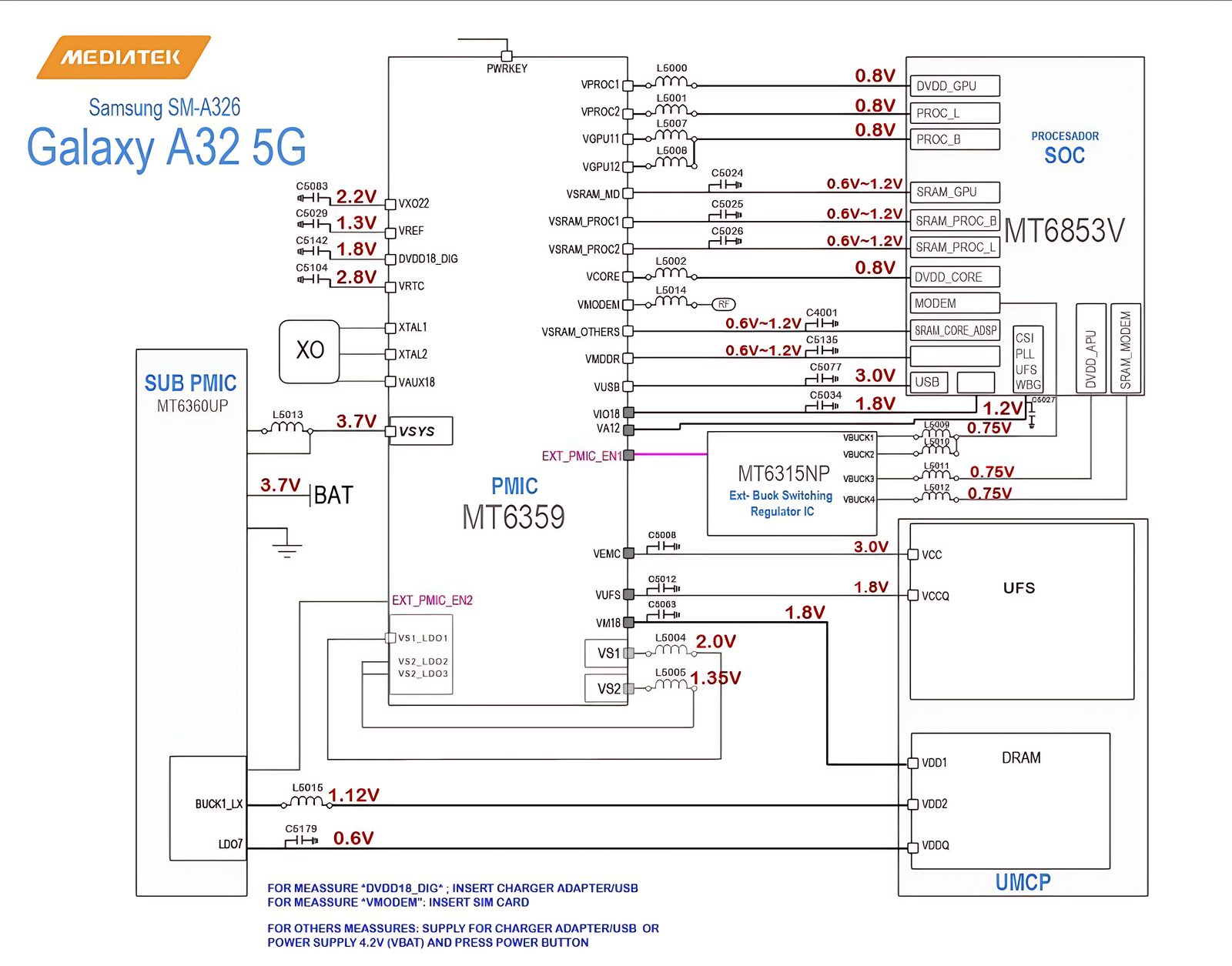Samsung Galaxy A32 5G (SM-A326) PMIC MT6359 Voltage Diagram
The Samsung Galaxy A32 5G (model SM-A326) is a budget-friendly 5G smartphone powered by the MediaTek MT6853V (Dimensity 720) processor. To support its advanced SoC, memory, and storage components, the phone integrates the highly capable PMIC (Power Management IC) — MT6359. This article explains the full power architecture of this device, using the detailed voltage diagram provided above, and outlines the role of every major power rail.

What is a PMIC and Why Does It Matter?
A Power Management Integrated Circuit (PMIC) is responsible for distributing power to all components of a smartphone. It converts the raw battery voltage (typically 3.7V) into various specific voltage levels needed by the processor, memory, storage, modem, and other parts of the phone. Without a well-designed PMIC, the system would be inefficient, unstable, or even dangerous.
In the Galaxy A32 5G, the PMIC used is the MediaTek MT6359, which works alongside other companion ICs like the MT6315NP (external buck switching regulator) and MT6360UP (sub PMIC) to power the entire platform efficiently.
Battery and Input Voltage
The device's battery provides a nominal voltage of 3.7V, which is fed to the MT6359 PMIC via the VSYS line. This is the main power input for the PMIC, and from here, it generates multiple regulated voltages for various subsystems.
Main Power Rails and Their Roles
Below is a breakdown of the major voltage rails generated by the MT6359 PMIC and their respective purposes:
- VPROC1, VPROC2 (0.8V): Power the main CPU cores (PROC_L, PROC_B) in the MT6853V SoC.
- VGPU1, VGPU2 (0.8V): Supply the GPU cores responsible for graphical processing.
- VSRAM_PROC1/2 (0.6V - 1.2V): Provide power to internal SRAM for CPU cores, with dynamic voltage scaling.
- VCORE (0.8V): Core logic supply for internal operation of the SoC.
- VMODEM (0.6V - 1.2V): Modem-specific power rail, essential for 5G, 4G, and other cellular activities.
- VUSB (3.0V): Powers the USB controller and peripheral interface.
- VA12 (1.8V): Analog voltage rail, often used for various I/O and peripheral support.
External Buck IC – MT6315NP
This IC supports additional high-efficiency buck conversion for power rails like:
- VBUCK1/2/3/4 (0.75V each): Typically used for powering UFS storage, I/O, or additional processor subsystems.
- VBUCK5 (1.2V): Can supply critical analog or digital blocks inside the SoC.
These voltages are necessary for fine-tuned control over high-speed interfaces and low-power states.
Memory Power — DRAM and UFS (UMCP)
The Galaxy A32 5G integrates a Unified Memory and Storage Package (UMCP), combining LPDDR4x RAM and UFS flash storage. Here's how power is distributed:
- DRAM:
- VDD1 (0.75V) and VDD2 (0.75V): Core supply voltages for LPDDR4x.
- VDDQ (0.75V): I/O voltage for data signaling between RAM and SoC.
- UFS:
- VCC (3.0V): Main storage flash voltage.
- VCCQ (1.8V): I/O voltage for UFS interface.
Auxiliary Voltages
The diagram also includes various auxiliary voltages:
- VX022 (2.2V): Used in RF or other analog blocks.
- VREF (1.3V) and DVDD18_DIG (1.8V): For internal digital logic and reference voltages.
- VRTC (2.8V): Real-Time Clock domain, retains timekeeping when phone is off.
- VAUX18 (1.8V): Analog subsystems like camera sensor power, etc.
Sub PMIC — MT6360UP
This chip complements the main PMIC by handling charging, battery protection, and sometimes LED drivers or Type-C detection. It interfaces with the battery and provides the main 3.7V supply to VSYS via inductor L5013.
Low Drop-Out (LDO) Regulators
The MT6359 includes several LDOs for low-noise power rails:
- LDO7: 0.6V – often used for camera analog or RF frontend
- BUCK1_LX: 1.12V – powers intermediate logic blocks
- VS1: 2.0V, VS2: 1.35V – generic I/O and baseband support
Dynamic Voltage Scaling (DVS)
Some power rails like VSRAM_PROC, VMODEM, VDDC support voltage scaling from 0.6V to 1.2V based on processor load. This enhances efficiency and reduces power drain during idle states.
Why This Voltage Map is Important
For technicians, engineers, and repair professionals, such a voltage map is crucial:
- Helps diagnose dead or stuck devices
- Allows pinpointing faulty regulators or shorted lines
- Assists in board-level repair and validation
- Provides insight into the smartphone’s power design
Conclusion
The Samsung Galaxy A32 5G is powered by a complex and efficient power delivery system based on the MT6359 PMIC, working in tandem with external buck regulators and a sub PMIC. The voltage map reveals a sophisticated and fine-tuned approach to managing power across high-speed 5G modem, fast memory (UMCP), and MediaTek's powerful Dimensity SoC.
Understanding these power rails can help with everything from device repair and diagnostics to designing aftermarket tools or firmware. It’s a true window into how modern smartphones stay fast, cool, and efficient — all thanks to intelligent power management.
